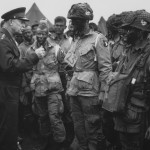
We tend to make a lot of jokes at the expense of the television weather people. How can you make a mistake when you have the $7,000,000 Doppler system? In Southern California the joke was why they were paid for predicting weather that every day was 75 degrees, no clouds, and no rain. Here’s the story of one of the most important weather forecasts in modern history. The launch of the Normandy invasion—code name: Neptune—hinged on the weather. There were only several days each month when ideal conditions existed: a full moon, high tides, and time of the day. Eisenhower picked 5 June 1944 to send the men in. Unfortunately, the weather turned nasty on 3 June with strong winds, heavy seas, and high surf. These conditions continued and the decision was made to postpone the invasion for 24-hours. The invasion would have to wait another two weeks if further delayed.
At 9:30 PM on 4 June, Group Captain James Stagg, chief meteorologist, reported to Eisenhower that a 36-hour break in the weather was imminent for 5 June and into the morning of 6 June. At 4:30 AM, Eisenhower said “Okay, let’s go” and he gave the orders for the invasion to begin. Everything after that is history. But how did Group Captain Stagg know that a 36-hour “window” of good weather was on the horizon (no pun intended)?
Predicting the Normandy Weather
Read the full article: Lighthouse Keeper Ted Sweeney
On the western most side of Ireland (Blacksod) is the Mayo lighthouse. The light keeper at the time, Ted Sweeney, was responsible for weather reports on the half and full hour. Weather patterns were seen first from this western point as they moved east towards Britain, across the channel, and then to Europe.
Sweeney’s reports from Blacksod resulted in the 24-hour delay and ultimately, Ike’s decision to go on the morning of 6 June. As Sweeney reported to London during this 72-hour period, he had no idea that the decision to invade would be based on his weather updates. KEEPERS OF THE LIGHT So when it’s raining outside and your picnic gets cancelled because the local weather forecast called for sunny skies (based on that expensive Doppler machine), remember the story of the weather forecast from an Ireland lighthouse built in 1864.
Do we have a lot of stories? Of course we do. I’m looking forward to sharing these with you. Please continue to visit our newsletter and blog. Perhaps you’d like to subscribe so that you don’t miss out on the most recent newsletter and blog posts.
Thanks so much for following my newsletter and blogs as well as my little journey through this incredibly interesting process of writing a series of niche walking tour books based on European historical periods or events. Please note that I do not and will not take compensation from individuals or companies I mention or promote in my blog.
Share This:
Follow Stew:
Find Stew’s books on Amazon and iBooks.
Please note that we do not and will not take compensation from individuals or companies mentioned or promoted in the blogs. Walks Through History
Walks Through History
Copyright © 2015 Stew Ross


